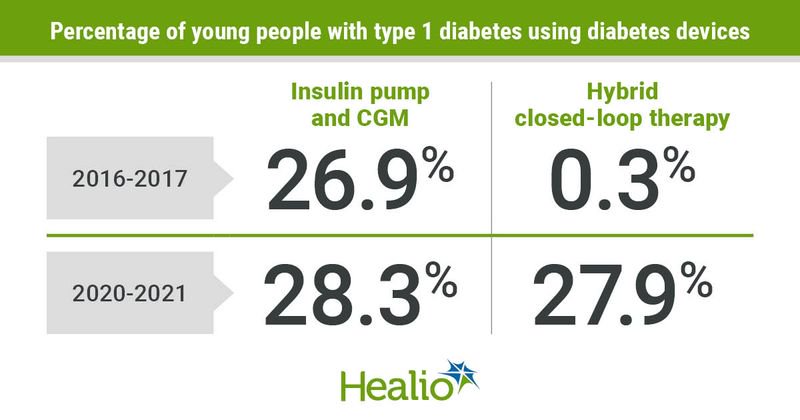Increased use of CGM, hybrid closed-loop therapy tied to lower HbA1c in pediatric diabetes
Click Here to Manage Email Alerts
Key takeaways:
- The rate of CGM use among youths and young adults with type 1 diabetes more than doubled from 2016-2017 to 2020-2021.
- HbA1c increased over time for youths using blood glucose meters instead of CGM.
The use of continuous glucose monitoring and hybrid closed-loop insulin delivery systems increased among youths with type 1 diabetes from 2016-2017 to 2020-2021 and may have helped reduce HbA1c, according to a brief report.
“Although CGM technology improved between the periods, patients using CGM had similar HbA1c across the time periods, a trend that remained when restricting analysis to those who had data in both periods,” G. Todd Alonso, MD, associate professor at the Barbara Davis Center for Diabetes at the University of Colorado, and colleagues wrote in a study published in Diabetes Care. “Thus, the overall decrease in HbA1c across the population is consistently associated with the relative increases in the size of CGM and hybrid closed-loop groups.”

Researchers obtained electronic medical record data from youths and young adults aged 21 years and younger with type 1 diabetes for more than 3 months who attended the pediatric clinic at the Barbara Davis Center for Diabetes from October 2016 to March 2017 or October 2020 to March 2021. Demographics, HbA1c, insulin regimen and diabetes device use at the most recent visit during each 6-month period were collected. The cohort was divided into five groups based on device usage: multiple daily injections with a blood glucose meter, insulin pump with a blood glucose meter, multiple daily injections with CGM, insulin pump with CGM without hybrid closed-loop and hybrid closed-loop insulin delivery.
The study included 4,103 youths and young adults with type 1 diabetes of whom 2,827 had data available in 2016-2017 and 2,731 had data available from 2020-2021. There were 1,455 participants with data available in both time periods.
From 2016-2017 to 2020-2021, the percentage of young people using an insulin pump and CGM increased from 26.9% to 28.3%, usage of a hybrid-closed system increased from 0.3% to 27.9%, and the percentage of people using multiple daily injections with CGM increased from 5.8% to 19.1%. The proportion of the cohort using an insulin pump and blood glucose meter declined from 34.3% to 9.8%, and the percentage receiving multiple daily injections with a blood glucose meter dropped from 32.8% to 14.9%. Overall, the percentage of participants using a CGM more than doubled from 32.9% in 2016-2017 to 75.3% in 2020-2021. There was also a slight increase in the proportion of the cohort using insulin pumps from 61.4% to 66%.
Mean HbA1c in the cohort decreased from 8.9% in 2016-2017 to 8.6% in 2020-2021 (P < .0001). Among youths using multiple daily injections and blood glucose meters, HbA1c increased from 9.4% in 2016-2017 to 9.9% in 2020-2021 (P < .0001). Youths using an insulin pump and blood glucose meter also had an HbA1c increase from 9.2% in 2016-2017 to 9.8% in 2020-2021 (P = .003). There was no significant change in HbA1c for the other three groups.
Of young people with data in both time periods, 962 switched groups from 2016-2017 to 2020-2021. Among those who switched, HbA1c declined from 8.9% to 8% for those switching from insulin pump and blood glucose meter to hybrid closed-loop (P < .001) and from 8% to 7.6% for those switching from an insulin pump and CGM to hybrid closed-loop (P = .001). Young people who switched from an insulin pump and CGM to an insulin pump and blood glucose meter had an increase in HbA1c from 9.1% in 2016-2017 to 10.1% in 2020-2021.
“This real-world study demonstrates sharp increases in CGM, and hybrid closed-loop use being strongly associated with lower HbA1c across a pediatric clinic population, a welcome finding after many years of apparent stagnation or deterioration in HbA1c trends seen in the T1D Exchange clinic registry,” the researchers wrote.
The researchers said addressing barriers to diabetes technology uptake may further improve HbA1c trends, reduce disparities and decrease risks for diabetes-related complications.
